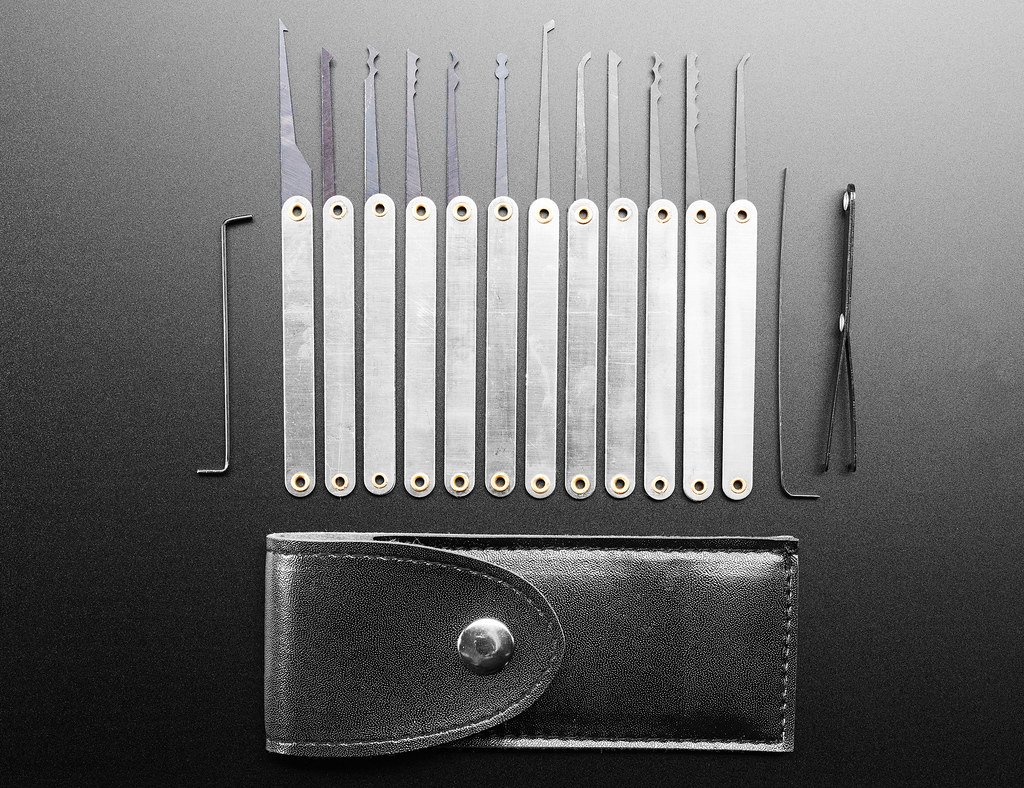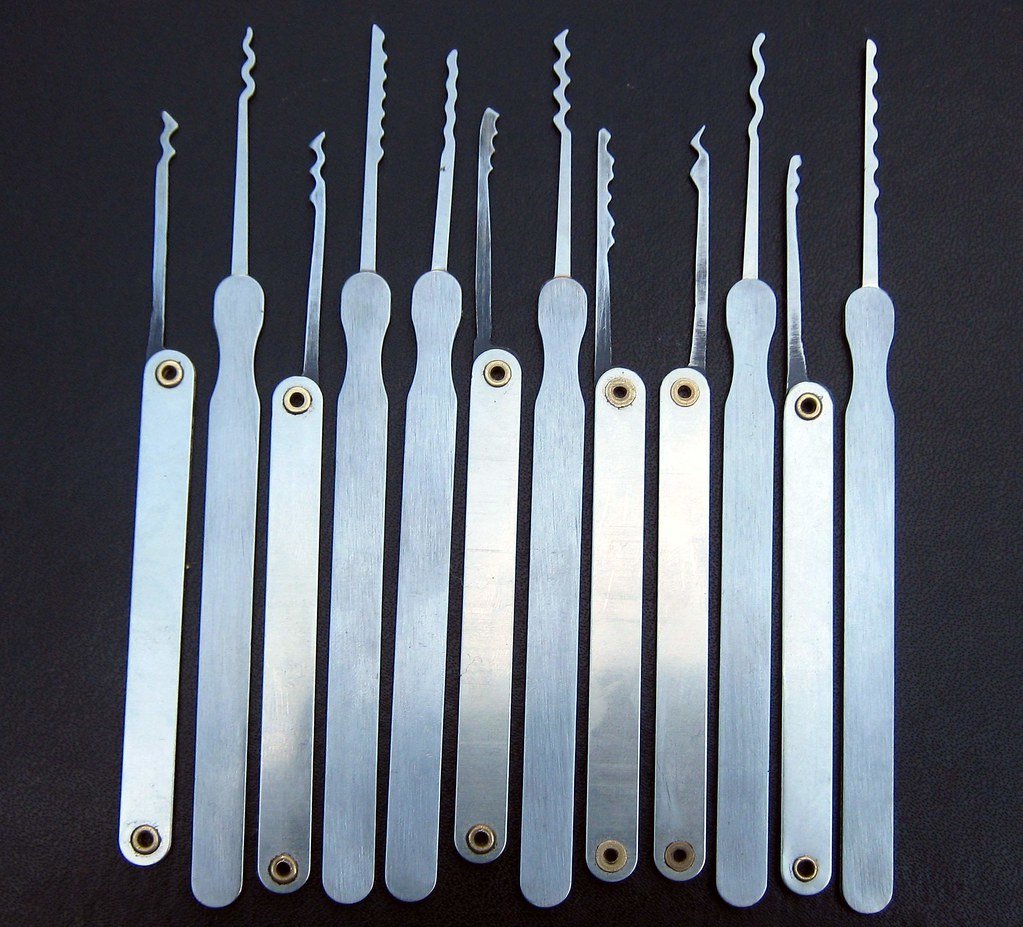Are you ready to embark on a thrilling journey into the secret world of lock picking? When it comes to choosing your very first lock picking set, it’s essential to be equipped with the right tools and knowledge to unlock the door to a whole new realm of possibilities. Whether you’re an aspiring locksmith, hobbyist, or simply curious about the art of picking locks, this guide will unravel the mysteries and complexities surrounding the selection process. So, grab your imaginary detective hat and let’s delve into the fascinating realm of lock picking.
Table of Contents
- Heading 1: Understanding the Essentials: A Beginner’s Guide to Lock Picking Sets
- Heading 2: Factors to Consider when Selecting Your First Lock Picking Set
- Heading 3: Exploring Different Types of Lock Picking Tools and their Applications
- Heading 4: Recommendations for High-Quality Lock Picking Sets for Beginners
- Heading 5: Additional Resources and Tips to Enhance Your Lock Picking Skills
- Q&A
- In Conclusion

Heading 1: Understanding the Essentials: A Beginner’s Guide to Lock Picking Sets
Are you fascinated by the art of lock picking? Ready to embark on a journey of unraveling the mysteries behind locked doors? Look no further - this beginner’s guide to lock picking sets will equip you with the essential knowledge you need to get started.
First and foremost, it’s important to understand the key components of a lock picking set. These sets typically include various tools designed to manipulate different types of locks. Some common tools you may find in a lock picking set include:
- Tension wrenches: These tools are used to apply tension to the lock, creating the necessary pressure to manipulate its internal mechanisms.
- Picks: Picks come in different shapes and sizes and are used to manipulate the individual pins within the lock. They allow you to set each pin to the correct position to successfully open the lock.
- Rake picks: Rake picks are used for a technique known as “raking” or “scrubbing,” where you rapidly move the pick across the pins to quickly manipulate them into position.
It’s essential to invest in a high-quality lock picking set, as cheap or poorly made tools can be ineffective and even damage the locks you are attempting to pick. Additionally, proper technique and practice are crucial to becoming proficient in lock picking. Remember, lock picking is a skill that requires patience, precision, and a thorough understanding of the mechanisms at play.

Heading 2: Factors to Consider when Selecting Your First Lock Picking Set
Factors to Consider when Selecting Your First Lock Picking Set
Embarking on the journey of lock picking can be an exciting endeavor, but selecting the right tools to begin with is crucial. Here are a few factors you should consider when picking your first lock picking set:
- Quality: Investing in a high-quality lock picking set will not only ensure durability but will also provide better precision and control while practicing your skills. Look for sets that are made from sturdy materials and have a reputation for reliability.
- Types of Locks: Consider the types of locks you intend to practice on. Different locks require different tools, so it’s essential to choose a set that offers a variety of picks and tension wrenches suitable for a range of lock types.
- Beginner-Friendly: Opt for a set that is specifically designed for beginners. These sets often come with clear instructions, helpful diagrams, and may include practice locks to aid your learning process. Starting with a beginner-friendly set will help you build confidence and develop your skills gradually.
- Budget: It’s important to establish a budget before diving into lock picking. Sets can vary in price, so determine how much you’re willing to invest. Remember, quality should be prioritized over quantity. It’s better to have a few well-made tools than a large collection of subpar ones.
- Reputation & Reviews: Research the reputation of the brand and read reviews from users who have already experienced the lock picking set firsthand. This will give you an honest insight into the quality, effectiveness, and customer satisfaction.
By taking these factors into account, you’ll be well-equipped to choose your first lock picking set wisely. Remain patient, practice diligently, and explore the fascinating world of lock picking with the right tools at your disposal!

Heading 3: Exploring Different Types of Lock Picking Tools and their Applications
Exploring Different Types of Lock Picking Tools and their Applications
Unlocking the secrets behind lock picking requires an understanding of the various tools used by locksmiths and enthusiasts alike. These tools come in a wide range of shapes and sizes, each with its unique application. Let’s delve into the fascinating world of lock picking tools and explore the different types and their functions:
1. Tension Wrenches:
Considered the backbone of any lock picking arsenal, tension wrenches are used to apply torque to the lock cylinder, creating tension necessary for picking. These tools come in various shapes and sizes to accommodate different lock types. From bottom-of-the-keyway to top-of-the-keyway tension wrenches, the options are vast for every lock picking enthusiast.
2. Lock Picks:
Lock picks are the key to manipulating the intricate mechanisms within a lock. They are crafted to mimic the functionality of a regular key, allowing the picker to manipulate the pins and other components. These picks include various designs such as hooks, rakes, diamonds, and ball picks, each serving a different purpose. The versatility of lock picks allows for adaptation to different lock types, providing endless possibilities for opening even the most challenging locks.
3. Bypass Tools:
When traditional lock picking methods fail, bypass tools come to the rescue. These innovative tools work by sidestepping the lock entirely, avoiding the need to pick it. Bypass tools include items like shims, bump keys, and plug spinners, which can be used to open locks quickly and efficiently. While they require some skill to use effectively, bypass tools offer an alternative solution for both locksmiths and individuals in emergency situations.
With an understanding of the diverse array of lock picking tools available, one can approach the skill with a greater appreciation for the complexity and craftsmanship involved. Remember, always ensure you have proper authorization before attempting to use these tools, as lock picking without permission is illegal.
Heading 4: Recommendations for High-Quality Lock Picking Sets for Beginners
Recommendations for High-Quality Lock Picking Sets for Beginners
When it comes to starting your lock picking journey, having the right tools is essential. Investing in a high-quality lock picking set can make all the difference in your learning experience. Here are a few recommendations that cater specifically to beginners:
- The Sparrows Tuxedo Set: This comprehensive set is perfect for beginners looking for a well-rounded collection of quality picks. It includes a variety of hooks, rakes, and tension wrenches, all crafted with precision.
- Peterson GSP Ghost Pro Set: Known for their exceptional craftsmanship, the Peterson GSP Ghost Pro Set features stainless steel picks that offer superior durability and longevity. This set is perfect for those seeking a professional feel right from the start.
- The SouthOrd PXS-14: Ideal for beginners on a budget, the SouthOrd PXS-14 is an affordable set without compromising on quality. It includes a selection of picks, rakes, and tension tools, making it a great choice for those just starting out.
Remember, regardless of the set you choose, practice is key. Lock picking requires patience and finesse, so take your time and enjoy the learning process. Happy picking!
Heading 5: Additional Resources and Tips to Enhance Your Lock Picking Skills
In your journey to becoming a master lock picker, we understand that you may be hungry for more knowledge and techniques. That’s why we have compiled a list of additional resources and tips to take your skills to the next level.
Here are a few ways you can enhance your lock picking abilities:
– **Expand Your Library**: Immerse yourself in the world of lock picking by exploring books and publications dedicated to the subject. From beginner-friendly guides to advanced techniques, these resources provide valuable insights and tips from experienced professionals.
– **Join Online Communities**: Connect with fellow lock picking enthusiasts through online forums and communities. Engaging in discussions with like-minded individuals can help you expand your knowledge, gain new perspectives, and exchange valuable tips and tricks.
– **Practice, Practice, Practice**: As with any skill, practice is key to mastery. Regularly challenge yourself with different locks of varying complexities, and strive to improve your technique. Remember, patience and persistence are the ultimate keys to success in the realm of lock picking.
By utilizing these additional resources and implementing these tips, you’ll be well on your way to becoming a proficient lock picker. Remember, always practice this skill ethically and responsibly. Happy lock picking!
Q&A
What are the important factors to consider when choosing a lock picking set?
When choosing a lock picking set, it is essential to consider factors such as the quality of the tools, versatility, and the types of locks you plan to work on. Additionally, the level of experience and skill should be taken into account to ensure you have the appropriate tools for your proficiency level.
Why does the quality of lock picking tools matter?
The quality of lock picking tools greatly affects their durability and effectiveness. Investing in high-quality tools ensures they will withstand regular use and provide reliable performance, increasing your chances of successfully picking locks and avoiding frustration.
Should I opt for a beginner set or individual tools?
For most beginners, it is recommended to start with a comprehensive beginner set. These sets often include a variety of tools and can help you practice different techniques on various lock types. Once you’ve gained experience and identified your specific needs, you can consider expanding your collection with individual tools.
How can I determine the types of locks I will be practicing on?
It is best to consider the type of locks commonly found in your country or region. Researching the most common lock types and their corresponding picking techniques will help you choose a set that fits your needs. Additionally, obtaining locks from different manufacturers can provide a wider range of practice opportunities.
What tools should be included in a basic lock picking set?
A basic lock picking set should typically include at least a few different tension wrenches and a variety of picks such as a hook pick, a rake pick, and a diamond pick. These tools will allow you to experiment with different techniques and handle various lock mechanisms.
Should I invest in lock picking training resources?
Lock picking training resources, such as books or online courses, can greatly enhance your skills and knowledge. They provide valuable insights into different lock mechanisms, picking methods, and professional tips. Investing in these resources can significantly accelerate your learning curve and help you become a proficient lock picker.
Is it legal to own a lock picking set?
In most countries, owning a lock picking set is legal for individuals who have a legitimate purpose, such as professional locksmiths, hobbyists, or those engaged in lock sport activities. However, it is crucial to understand and adhere to your local laws and regulations regarding lock picking to ensure you use your skills responsibly and legally.
In Conclusion
In the captivating world of lock picking, we have unravelled the secrets behind choosing your first lock picking set. As we close the doors on this insightful journey, we hope this article has equipped you with invaluable knowledge and ignited a spark of curiosity within. Remember, dear reader, mastery of this art requires practice, patience, and above all, utmost respect for the laws and ethics that govern its boundaries. So, whether you’re seeking solace in the mesmerizing art of lock manipulation or envisioning a future as a seasoned locksmith, let your journey begin – armed not just with the right tools, but with an insatiable hunger for unlocking the mysteries that lie beyond those impenetrable barriers. As you embark on this thrilling endeavor, may your endeavors be mindful, your learning tenacious, and your craftsmanship an homage to the extraordinary beauty of the intricate mechanisms that guard our wondrous world. Open doors, open minds, and may your picks always find the perfect alignment.
As an affiliate, my content may feature links to products I personally use and recommend. By taking action, like subscribing or making a purchase, you’ll be supporting my work and fueling my taco cravings at the same time. Win-win, right?
Want to read more? Check out our Affiliate Disclosure page.